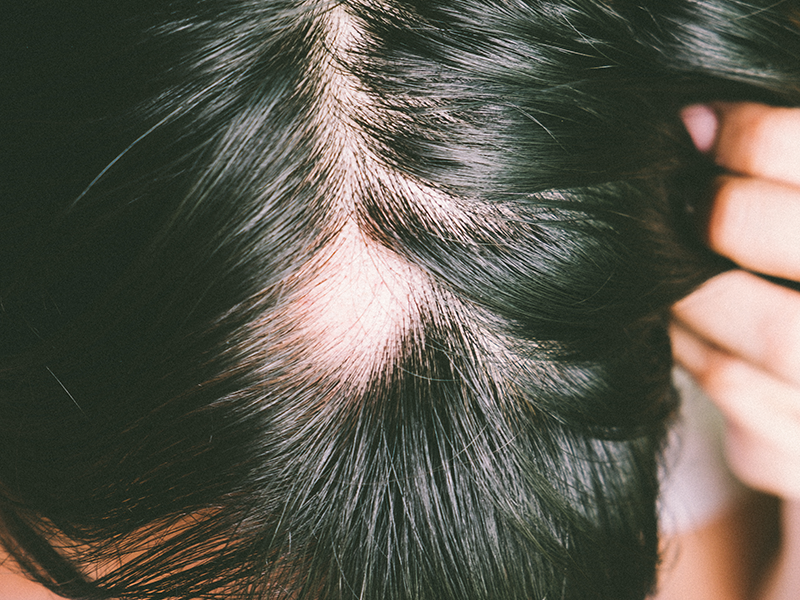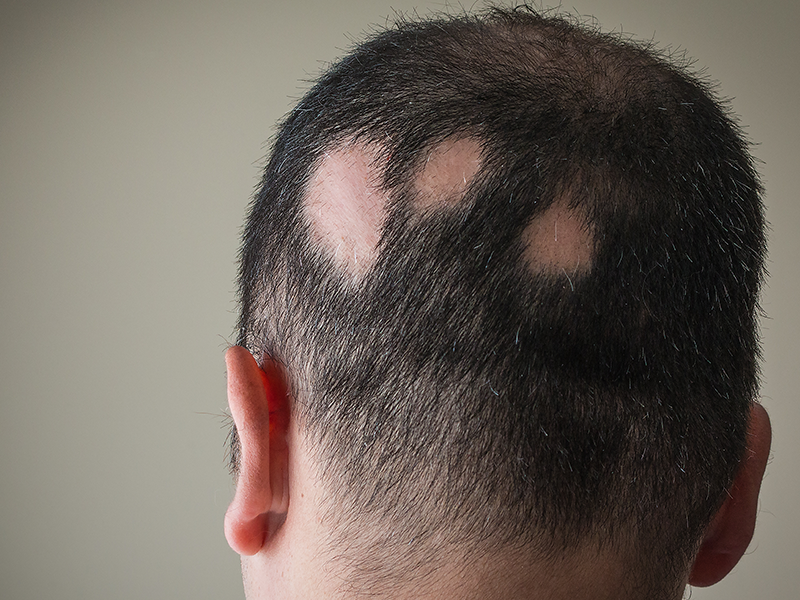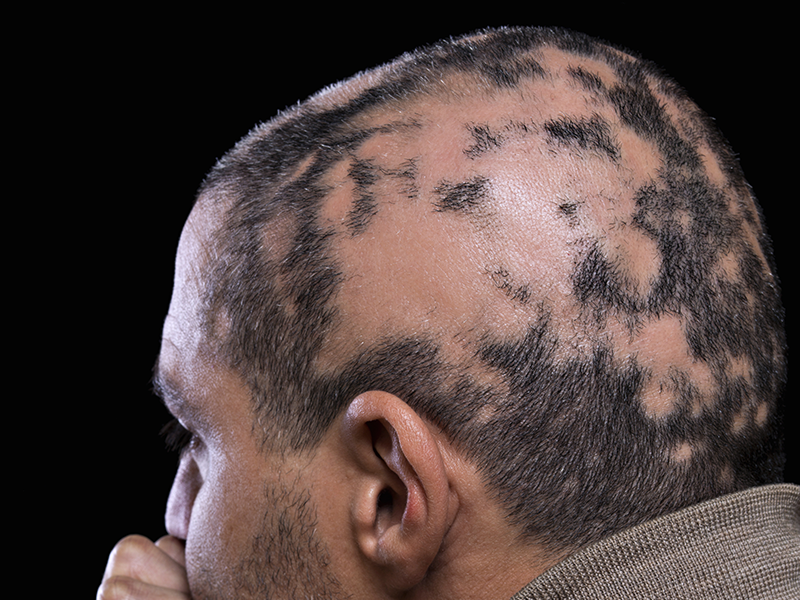Treating Alopecia and Hair Loss in London.
Alopecia and hair loss mean the same thing; reduction in hair density and increased hair fall. This can be a diffuse process or occur in localised areas on the scalp or other areas of the body. It can occur slowly over many years, or be rapidly progressive, occurring over days or weeks. There are many causes for alopecia which can broadly be grouped into three categories: internal deficiencies, scalp disease or ‘other’ causes. The most important distinction is whether scarring is a feature or not, because this will dictate how successful treatment can be.
Hair loss can occur for many different reasons and it is a very common and distressing problem. At the Harley Street Dermatology Clinic, we know just how troubling it can be to lose one’s hair. The most important step is to firstly establish the cause for your hair loss, and then, provided it is treatable, to try and reverse it.
If you are suffering from hair loss, the sooner you seek treatment the better results will be, and no amount of hair loss is too small to seek advice about. If you have already tried over the counter remedies and are still suffering from hair loss, we can help. Our experts hair loss dermatologists are able to diagnose your hair loss and to treat it in the most effective way for you.
REQUEST A CALL BACK
Arrange a consultation with one of our expert dermatologists today.
WHAT CAUSES HAIR LOSS?
Hair loss can happen for many reasons and progress in a variety of patterns. You may have noticed a patch of baldness that has begun to grow, or a receding hairline at your temples or forehead and decided to do something about it before it gets any worse. Or, you may have noticed an increase in hairs on your pillow or clothes, indicating that you are shedding hairs at an increased rate, even if there is no visible thinning of the hair. Whatever concerns you have about your hair or scalp, our experts at the Harley Street Dermatology Clinic are here for you. Every case is unique and we provide each patient with personalised specialist care and treatment to achieve the best results possible, whatever the cause.

Non-Scarring
- Androgenic or genetic alopecia is the commonest cause of hair loss in men and women
- Iron deficiency or low ferritin can cause hair loss
- Thyroid related hair loss might be due to over or under-active thyroid
- Alopecia Areata is usually patches of hair loss caused by the immune system
- Telogen effluvium is stress or illness related hair loss
- Age related hair loss occurs in all people over time
- Drug induced hair loss can occur as a result of some medications i.e. Roaccutane®
- Trichotillomania; self induced hair loss through uncontrolled plucking
- Stress can exacerbate any of the above conditions
Scarring
- Traction/Traumatic alopecia is due to scalp damage (often through excessive braiding)
- Lichen plano-pilaris; an inflammatory scalp condition
- Lupus; an autoimmune condition that can affect the scalp
- Folliculitis/dissecting Cellulitis; hair follicle inflammation that can lead to scarring
- Pseudopelade is end stage scarring alopecia of uncertain cause
WHAT ARE THE MAIN TYPES OF HAIR LOSS?
There are two main types of hair loss and these are described by dermatologists as scarring or non-scarring.
SCARRING ALOPECIA
Scarring alopecia results in permanent hair loss, so it is really important for early diagnosis and treatment to slow down the adverse effects.
In scarring alopecia, hair follicles become inflamed and are replaced with scar tissue on the skin on the scalp. For this reason, when hair loss has occurred, there is no potential for the hair to recover in those areas. Although this process is irreversible that does not mean these conditions are untreatable. As is often the case, early diagnosis and treatment is vital to limiting the damage caused by the disease. The scarring alopecias require careful and expert management as an accurate diagnosis of the problem is vital to choose the most appropriate treatment. Sometimes a diagnosis requires a skin sample (biopsy) of the skin.
NON-SCARRING ALOPECIA
Non scarring hair loss is where no scarring is present. With this form of hair loss there is little irritation or inflammation, but hair loss can be significant. Hair loss here can either appear in patches, or be spread throughout the hair. Examples of non scarring alopecia are:
MALE PATTERN HAIR LOSS
By far the most common cause of hair loss in men is male pattern hair loss (MPHL). This condition is also referred to as androgenetic alopecia. Although scientists are not completely certain what determines who gets male pattern hair loss, we do know there is a genetic component to the condition that can be inherited from either parent’s side of the family.
Male pattern hair loss is identified by the hair it affects. In male pattern baldness, hair on the top of the head is affected, whereas hair on the back and sides of the scalp is spared. MPHL generally progresses in one of three ways; a receding hairline, thinning of the hair on the crown, or a general thinning of the hair all over the top of the head.
The key is to catch it as early as possible, ideally, as soon as you notice any thinning or loss of hair, the sooner you can begin treatment the greater your chance of achieving a good recovery. If you think you may be suffering with male pattern hair loss, make an appointment with our expert dermatologists today.
FEMALE PATTERN HAIR LOSS
Female pattern hair loss, also sometimes called androgenetic alopecia, affects thousands of women in the UK, usually beginning at around 30 years of age and occasionally earlier. Typically, women present with gradual thinning of the hair at the top of the head and widening of the hair part. Despite similarities with male pattern hair loss, the exact causes of FPHL is less clear. Elevated levels of testosterone or increased sensitivity to the hair follicles to this hormone is a factor in some, but not all, who have this condition. The balance of other hormones in the body and genetic factors are also likely to be important in causing this hair loss.
A number of treatments are clinically proven to stop further hair loss and in many cases reverse it, leading to a recovery of hair thickness and coverage. As with MPHL, early treatment is important as it is much easier to maintain the hair density than to recover it once it has been lost.
ALOPECIA AREATA
Alopecia Areata (AA) is a form of hair loss that affects both men and women causing bald patches to suddenly appear on the scalp or body. This happens when groups of hair follicles prematurely enter the shedding phase of the hair cycle. It is thought to be an autoimmune disorder, where the body’s immune system attacks the hair follicle root by mistake. We do not know what causes a person to develop AA, but a variety of potential triggers have been identified including infections and severe emotional stress.
Treatment for alopecia areata depends on the site and size of the affected areas. Steroids can be used either topically or as injections into the scalp to reduce the immune response and allow the hair to regrow. Larger areas are treated with topical treatments such as diphencyperone immunotherapy or dithranol and sometimes tablets can be used. Patches can also regrow by themselves, although there is no way of predicting if or when this might happen. Since AA can appear suddenly and progress rapidly, early treatment is generally recommended to increase the chances of a recovery.



HOW CAN ALOPCIA AND HAIR LOSS BE TREATED?
The most important part of treatment is to make the correct diagnosis. Our specialist hair loss consultants are fully qualified with the right experience to diagnose the cause of hair loss. Diagnosis involves a consultation, full scalp examination and sometimes blood testing to establish if there is a deficiency or hormonal problem. If scalp disease is present or a diagnosis is not straightforward, a scalp biopsy might be undertaken to examine the process at a microscopic level.
The key to treatment is establishing if the condition is scarring or not. If it is scarring, it is important to switch off the process as quickly as possible to prevent progression, as scarred areas will not regrow. Non-scarring alopecia can recover fully with treatment but may gradually progress over time. It is vital to make the correct diagnosis and prevent any scarring, or alopecia can become irreversible.
The current options of treatment for hair loss include prescription drugs, which can bring partial improvements, surgical hair restoration which addresses symptoms but not the underlying medical problem, and platelet rich plasma which is a newer treatment and has shown benefit in multiple recent studies in hair restoration.
STEROID CREAMS, INJECTIONS AND TABLETS
Steroid creams can be applied to bald patches to stimulate hair growth and steroid injections can be used to treat small patches of hair loss. Tablets can be taken to encourage hair growth but alopecia can often return when the treatment stops.
PLATELET RICH PLASMA TO TREAT HAIR LOSS
Platelet Rich Plasma (PRP) is a pioneering new treatment that is highly effective and uses the patient’s own platelets cells from their blood, which are rich in various growth factors, to stimulate hair growth. The growth factors in PRP can hugely benefit people suffering from hair loss or hair thinning. Current estimates suggest that a benefit is attained in at least 30-40% of selected patients. PRP serves to promote the growth of hair by stimulating the stem cells located in the dermal papilla along with the other cell structures present in the hair follicle. PRP cannot cause growth of new hair follicles once they have died or where they have not existed before.
The technique of platelet rich plasma involves the withdrawal of your own blood, which is then processed into separate blood components of Platelet-Rich Plasma, Platelet-Poor Plasma and Red and White Blood Cells. Using a small needle, the platelets are then injected strategically into your scalp in the areas that need improvement. The whole procedure takes around 20-30 minutes and a course of three sessions (one per month) are advised, followed by a possible fourth treatment depending on the severity and placement of your hair loss. One or two maintenance treatments per year are recommended. The length of your treatment will be discussed with you during your hair loss consultation.
DIPHENCYPRONE (DCP)
Diphencyprone (DCP), also known as Diphenylcyclopropenone (DPCP), is an organic compound that is most often used in the treatment of alopecia areata. DCP works by inducing an allergic reaction in the skin, which leads to inflammation and the formation of new hair follicles. The treatment is typically applied once per week, and may need to be continued for several months before results are visible. Although DCP can be effective in treating alopecia areata, it can also cause side effects such as itching, redness, and burning. As a result, patients should be carefully monitored by a physician during treatment.
FREQUENTLY ASKED QUESTIONS
What is alopecia?
Alopecia and hair loss mean the same thing; reduction in hair density and increased hair fall. This can be a diffuse process or occur in localised areas on the scalp or other areas of the body. It can occur slowly over many years, or be rapidly progressive, occurring over days or weeks. There are many causes for alopecia which can broadly be grouped into three categories: internal deficiencies, scalp disease or ‘other’ causes. The most important distinction is whether scarring is a feature or not, because this will dictate how successful treatment can be.
What does alopecia look like?
Hair loss may be diffuse (i.e. androgenic) or localised (i.e. alopecia areata). If there is scarring, the skin might be featureless with loss of hair follicles and pigment.
How might alopecia affect me?
The degree of psychological stress caused by alopecia is usually related to the extent of alopecia and the ease (or lack thereof) with which the condition can be covered or hidden.
For further information on alopecia, see the British Association of Dermatologists websites patient information pages:
What is the main cause of alopecia?
Alopecia is an autoimmune disease, meaning cells in your immune system attack your hair follicles causing your hair to fall out.
WHY CHOOSE THE HARLEY STREET DERMATOLGY CLINIC?
Having the right dermatologist is important especially when you have a chronic skin condition that will require ongoing treatment. We want you to feel confident that we’re providing you with the best possible care. We also want you to feel as comfortable as possible with your dermatologist.
The Harley Street Dermatology Clinic specialises in conditions affecting the skin, hair and nails. Our goal is to provide all the care that you need when you’re experiencing these kinds of problems. We want to make it easy for you to access the best quality treatment and support in London.
The clinic is conveniently located in Central London, so it’s easy to visit us if you need to see a dermatologist. You will find yourself in a very comfortable and welcoming environment. We have created a relaxing space where you will receive the highest quality of care. We are regulated by the Care Quality Commission, are part of the British Association of Dermatologists and are top rated by patients of Doctify so you can be sure of safe and effective treatment with us.
CONTACT US
Finding Us
The Harley Street Dermatology Clinic
35 Devonshire Place
London
W1G 6JP
The clinic can be accessed by public transport, on foot or by car. There is paid on street parking around the Harley Street district. The nearest tube stations are Regent’s Park and Baker Street, and Marylebone train station is a 15 minute walk away.
Contact Details
Opening Hours
While appointments can be made available outside usual hours in special circumstances, our core hours are:
Monday: 8am - 6pm
Tuesday: 8am - 6pm
Wednesday: 8am - 6pm
Thursday: 8am - 6pm
Friday: 8am - 6pm
Saturday : 10am - 2pm
Sunday: Closed
REQUEST A CALL BACK
Please fill in this form and one of our team will give you a call back to arrange a consultation with one of our expert dermatologists.
